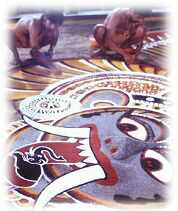Sunanda Nair has the proud privilege of being the first student to earn a Master's degree in Mohini Attam from Nalanda Nritya Kala Mahavidyalay affiliated to the University of Mumbai. Sunanda is the disciple of the noted Mohini Attam exponent Padmashree Dr.(Smt)Kanak Rele, who is renowned for her contribution to the revival and popularisation of this classical dance style. Sunanda has very reputed national and international festivals to her credit, and has won high acclaim from both the critics and conossieurs of dance for her impressive dancing. She has choreographed innumerable items in Mohini Attam and BharatNatyam.
Koodiyattam , Sanskrit drama performed in Kerala, India, has been recognised by UNESCO as a Human Heritage Art. Rightly so. It is the oldest existing classical theatre form in the entire world, having originated much before Kathakali and most other theatrical forms. It is considered to be at least 2000 years old. Kulasekhara Varma Cheraman Perumal, an ancient King of Kerala was known as the creator of Koodiyattam...
 |
| Add caption |
Shobana is a an accomplished Bharatanatyam dancer who runs a dance school and has worked on collaborative ventures with the likes of tabla maestro Zakir Hussain, Vikku Vinayakram and Mandolin Srinivas.. Her recitals abroad include those at the World Malayalee convention, in the United States in 1985 and 1995, in Kuala Lumpur before the King and Queen of Malaysia, numerous cities in the United States, Europe, South East Asia and Australia. She has had the distinction of inaugurating the dance and music season in Madras in 1992 at the Music Academy - the bastion of classical art...
Ottan Thullal , the dance form of Kerala is yet another gem in the vast repertoire of Kerala's performing arts. It has from its very inception, enjoyed a ready appeal with both the commoner and the connoisseur for unlike forms such as Koodiyattam, Krishnanattam, Kathakali and Mohiniyattam, it requires no initiation to intelligently respond to it. Kunchan Nambiar, the poet, social critic and humorist who lived two centuries ago was the pioneer behind this dance form...
Kalamezhuthu is unique form of this art found only in Kerala. Here it is essentially a temple art. The patterns to be drawn and the colours chosen are traditionally stipulated, and the tradition is strictly adhered to. The art of creating very large pictures on floor, with coloured powders have been in vogue for ages as a ritual art form. It is typically Indian as it is a harmonic blend of Arian, Dravidian and Tribal traditions. As an art form it has found a significant place among our rich spectrum of fine arts. The drawing is done directly with the hand, that is, without using any tools whatsoever.
Kalaripayatt is believed to be one of the oldest and comprehensive system of martial training prevailing in the world today. Though Kalaripayatt is the ancient martial art of KERALA, it is considered as the forerunner of all martial arts. The training consists of rigorous physical training besides training in self-discipline. The weapons used are the Sword, Shield, Dagger, Spear etc. and it requires whole co-ordination of the mind & body.
Thiruvathira or Kaikottikkali is a popular dance form of the women folk of Kerala. In this, eight to ten girls perform forming a circle by themselves. They sing and dance to the rhythm of clapping hands. Essentially a Kerala dance, hence the danseuse wear the typical dress of Kerala (Mundu and Veshti) with their hair beFebked with jasmine flowers.
Thrissur Pooram is the most colourful temple festival of Kerala, Thrissur Pooram attracts large masses of devotees and spectators from all parts of the State and even outside. Celebrated in Medom (April-May) it consists of processions of richly caparisoned elephants from various neighbouring temples to the Vadakumnathan temple, Thrissur. The most impressive processions are those from the Krishna Temple at Thiruvambadi and the Devi Temple at Paramekkavu which is quite a significant event for its devotees. Perhaps, there is no other festival in Kerala that draws such an unbelievable number of people to a single event.
Chakyar Koothu is a classical dance performed by the member of the professional Chakyar caste that too only in Koothambalam of temples. It is one of the oldest of theatrical arts peculiar to Kerala. The term Koothu literally means dance which may be taken as an index of the importance attached to dance in the original form of the art. As a matter of fact, the movements and facial expressions and the signs and gestures employed by the actor in Koothu are said to approximate most closely to the principles laid down in the authoritative Sanskrit treatise on the subject, Bharatha's Natya Sastra.
NEHRU TROPHY BOAT RACE the most colourful water sport in Kerala, is conducted at PUNNAMADA LAKE in Alappuzha on the second saturday of every August. This prestigious cultural event of Kerala has been attracting people from all over the world. Nehru Trophy Boat Race is a festival for the people of Alleppey the main attraction of which is the sportive sprits among the participants of the race. This trophy named as NEHRU TROPHY was donated by the late Prime Minister of INDIA Jawaharlal Nehru to the winners of the first boat race which was an impromptu one conducted in 1952 in honour of Panditji who visited Alappuzha This aquatic festival fosters a sense of unity and fraternity and sports man spirit event and attaching foreign tourists also.
.jpg)

.jpg)



.jpg)



